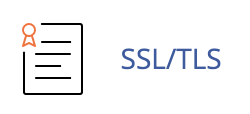How to install a self-signed SSL certificate in cPanel
This article describes how to generate and install a self-signed SSL certificate in cPanel.
Table of Contents
Installing a self-signed certificate
You can install a self-signed SSL certificate on your A2 Hosting account for testing and development purposes. To do this, you create a private key and digitally sign your own SSL certificate in cPanel.
To create and install a self-signed SSL certificate, follow these steps:
- Log in to cPanel.If you do not know how to log in to your cPanel account, please see this article.
- Open the SSL/TLS tool:
- If you are using the Jupiter theme, on the Tools page, in the Security section, click SSL/TLS:

If you are using the Paper Lantern theme, in the Security section, click SSL/TLS:

- If you are using the Jupiter theme, on the Tools page, in the Security section, click SSL/TLS:
- Under Private Keys (KEY), click Generate, view, upload, or delete your private keys. The Private Keys page appears.
- Under Generate a New Private Key, confirm that the Key Type is set to RSA, 2,048-bit.
- In the Description text box, type a descriptive name for the key, such as Self-signed cert key.
- Click . cPanel generates and displays the private key.
- Click Return to SSL/TLS.
- On the SSL/TLS page, under Certificates (CRT), click Generate, view, upload, or delete SSL certificates. The Certificates page appears.
- Under Generate a New Certificate, in the Key list box, select the description for the private key you generated in step 6.
- In the Domains text box, type the domain that you want to secure with the self-signed certificate, such as test.example.com.
Complete the remaining fields for the certificate.
Make sure you use the correct two-letter country code (for example, US or FR). For a complete list of these codes, please visit http://www.iso.org/iso/country_codes/iso_3166_code_lists/country_names_and_code_elements.htm.- Click . cPanel generates and displays the self-signed certificate.
- Click Return to SSL/TLS.
- From the SSL/TLS page, under Install and Manage SSL for your site (HTTPS), click Manage SSL sites. The Manage SSL Hosts page appears.
Under Install an SSL Website, click , select the certificate you generated in step 12, and then click . cPanel fills in the Certificate (CRT) and Private Key (KEY) fields automatically.
Because this is a self-signed certificate, the Certificate Authority Bundle (CABUNDLE) field remains blank.- In the Domain list box, select the domain you want to secure with the certificate.
- Click . cPanel installs the certificate on the server and enables SSL. When the process is complete, you receive an SSL Host Successfully Installed message.
- Click . You can now securely access the specified domain by using the https:// prefix in a web browser, but you will receive a warning message about the self-signed certificate.
Article Details
- Level: Intermediate
Grow Your Web Business
Subscribe to receive weekly cutting edge tips, strategies, and news you need to grow your web business.
No charge. Unsubscribe anytime.
Did you find this article helpful? Then you'll love our support. Experience the A2 Hosting difference today and get a pre-secured, pre-optimized website. Check out our web hosting plans today.